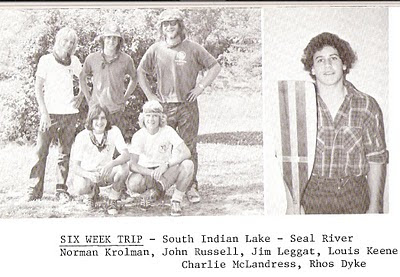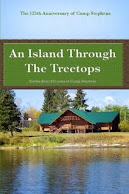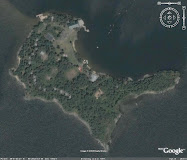By Bruce Owen
.jpg)
It will be 37 years ago this summer that Jim Leggat (left, up top) took five teenage boys on a trip of a life time.
The 1973 six week followed the route of the early voyageurs, 600 miles starting at Pukatawagan in northern Manitoba to the mouth of the Seal River at Hudson Bay.
“I learned more in those six weeks and in preparing for the trip than I had to that point in my life,” Rhos Dyke says.
“The trip changed me dramatically in how I carried on into 11th grade at Kelvin High School. I took on more responsibility at school and in the community. I learned a ton about teamwork.”
Dyke now lives in Los Angeles and is executive vice president at software company Cloud Creek Systems.
Also on the trip were John Russell, Louis Keene, Charles McLandress and Norm Krolman.
Russell, a professional engineer, splits his time between Las Vegas and Los Angeles. He is director of operations at Sebastian Construction Group, a builder of high-end homes.
“It was the high-light of my life,” Russell says. “I think Leggat was only 21 and we were 16. There was supervision, but compared to today’s standards we were pretty free-wheeling.”
McLandress, lives in Toronto and is a research scientist in the Department of Physics at the University of Toronto. He still paddles, and in 2006 canoed the Seal River a second time. “It taught me the importance of team work and the meaning of ‘group’ that can only come with such an experience,” McLandress says of the impact of the trip on him.
“Although I have many fond memories of the trip, the most vivid is our visit to a Sayisi Dene community on the shores of Tadoule Lake. They had only recently moved there from Churchill to ‘get back to the land’ and live the traditional life of hunting and fishing.
“We camped there one night, staying up late to watch the Northern Lights with some of the Dene boys and exchanging stories of our experiences as 16-year olds.”
Keene, an architect, lives in St. Simons Island, Georgia. He paints in his spare time.
“For me, it would not be overstating things to say that the experience gained that early in life really did set a course for me.
“I have continued to value travel at the top of my list. I have done a lot of mostly solo trips since, by motorcycle, sailboat and backpack through the Americas, the Middle East and Europe.
“I have always worked hard and done well enough but I am ambivalent about that part of life--moving down the road with endless days ahead and a sackful of good books to get into, ahhhhh – that’s it!
Two of the six on the trip have passed away.
Jim Leggat died suddenly Nov. 11, 1994 at age 41 while hiking in British Columbia. The first cabin on the line at Camp Stephens is named after him.
Norm Krolman, 39, disappeared Sept. 7, 1996 shortly after withdrawing cash from an ATM in Winnipeg.Winnipeg police say all of his belongings were still at his Wardlaw apartment, a sign the self-employed computer programmer intended to return. Foul play is suspected.
His brother Ranald says Norm was creating virtual-reality applications on his own at the time.
“I'm not sure either if I could write accurately about the impact the trip had on Norm,” Ranald said in an email. “It’s my mother’s retelling of Norm’s stories about the six-week trip that I remember better than his original telling of them, like his coming around a rock on a polar bear; his pulling out his knife; his showing us how large the bear's print was, to show what a derisory defense his knife would have been; the bear backing away.
“His voice, the story itself, is overwhelmed in my memory by the sound of my mother's exclamations, her feelings about the danger he'd been in, her conjecturing about the miraculous reprieve. But I think an impact of the trip may have been how it helped to develop in Norm an ability to stand up for himself. He'd been pretty cruelly bullied in school.”
For Dyke, Russell, Keene and McLandress, they went their own ways a long time ago. Like so many of us, university followed by careers, family and other things scattered them.
Late last year, Jim’s brother John gave me the logbook for the 1973 Camp Stephens Six Week Trip.
He said it the trip was unique not only because of the route, but because Leggat was the only tripper. It was also one of the early trips where more thought was put into making it challenging. Like canoeing and camping in polar bear country. Subsequent trips saw increased focus on safety, including two trippers.
“It was extremely challenging,” Russell says. “I remember dragging our canoes over deadfall and rocks in shallow creeks with the bugs draining the life out of me.
“I remember collapsing one night in the tent with barely setting it up and then back at it the next day.”
It started July 1. There was no sunrise ceremony; only a few goodbyes from trail staff; Jamie Grant, Mitch Halprin and Hugh Burton before the van pulled out of Winnipeg for The Pas.
When the van pulled into The Pas with Leggat, his boys and all their gear, the tone for the next six weeks was set.
Jim Leggat wrote: “We went up to Clearwater Provincial Park to look for a campsite. It was raining cats and dogs – couldn’t find one, everything was completely booked up – decided to ruff it and stay in a motel.
“We found the Wescana Inn – booked suite 17 but then we moved up to the executive suite and room 21 beside it – really nice.”
The first night of the trip was spent eating pizza, watching TV and throwing ice cubes at one another.
“We woke up at 6:45 a.m only to discover that the rain had not left us – oh poop!” Dyke wrote in the logbook. “We once again had scrambled eggs, once again we resisted the temptation to puke.”
The next day didn’t start on the water, but loading canoes and gear onto a train pointed towards Pukatawagan.
Leggat wrote as the train rolled north:
“The country seems to be getting pretty rough – started wondering what the hell we have signed up for.” About nine hours later the train stopped at Pawistik, a siding near Pukatawagan on the Churchill River.
The next morning, after an oatmeal breakfast, the two canoes hit the water.
The weather was perfect. Over the next couple of days they were ahead of schedule. And they hadn’t even broken a sweat. The fishing was also good.Louis, John, Norm, andChuck each caught fish, some they threw back, some they ate.
On the fourth day on trial it started raining.
“Decide to stay in bed,” Leggat wrote. “Broke camp around 10:30. Not to impressive – that’s too bad.
It rained steadily for the next few days.
In the days ahead the rain continued along with heavy winds. The rain they could handle. The wind, not so much. It whipped up the water making it dangerous to canoe on open water because of the high waves.
Waiting out the lousy weather and living in such close confines also brought out conflict.
“More strains on the trip are showing through as they boys were at each other’s throats in an argument over new positioning of the canoes,” McLandress wrote at the end of the second week. “Now once again tempers have died down and all grievances settled. We decided to hit the sack. That’s all for today. Covered 0 miles.”
When the weather changed the group of six made up for lost time on the Little Sand River.
“By now we were all rather upset at the bugs which seemed ravenous all the time,” Keene wrote.
Two days later the trip hit the Seal River. The boys lucked out when they came across a Lamb Air cabin, one of many scattered throughout the north used by the northern airline.
In the days ahead the six shot numerous rapids, one which saw one of their canoes badly crunched when it went through some white water sideways:
“When it was all over, only one paddle was missing and three boys had the symptoms of pneumonia,” the July 29 log book entry reads. “Jim tried to kick the now four foot dent out and succeeded partly.”
On July 31 the trip saw their first seal—they called it Herbie—and seven days later saw their first big polar bear.
“I was really scared because I didn’t know what it would do,” Dyke said in the logbook.
In the days ahead, as they paddled towards Hudson Bay, they saw more polar bears. A lot more.
A week later they flew to Winnipeg from Churchill. Then trail director Jim King met them at the airport and took them to Pizza Place before driving them out to Kenora. They’d covered the distance of the six-week trip in about six hours.
On August 16 they paddled into camp.
“Two days ago we were sitting at Hudson Bay wondering if we would make it home to Camp Stephens,” Dyke wrote in the log the night before. “Camp seemed to be far away and almost in another world.”
.jpg)
“Again the sun amazes us by just being present. Louis and Jim woke up first about 6:10. Louis, the pig, soon after came into our tent (Norm, Chuck and Rhos) and woke us up by violently vibrating his tonsils and excreting nauseating sounds. He and Rhos finally made breakfast and after all the duties were completed, we got on the water at 8:00. Not bad for this crew!”.-- July 10, 1973
It will be 37 years ago this summer that Jim Leggat (left, up top) took five teenage boys on a trip of a life time.
The 1973 six week followed the route of the early voyageurs, 600 miles starting at Pukatawagan in northern Manitoba to the mouth of the Seal River at Hudson Bay.
“I learned more in those six weeks and in preparing for the trip than I had to that point in my life,” Rhos Dyke says.
“The trip changed me dramatically in how I carried on into 11th grade at Kelvin High School. I took on more responsibility at school and in the community. I learned a ton about teamwork.”
Dyke now lives in Los Angeles and is executive vice president at software company Cloud Creek Systems.
Also on the trip were John Russell, Louis Keene, Charles McLandress and Norm Krolman.
Russell, a professional engineer, splits his time between Las Vegas and Los Angeles. He is director of operations at Sebastian Construction Group, a builder of high-end homes.
“It was the high-light of my life,” Russell says. “I think Leggat was only 21 and we were 16. There was supervision, but compared to today’s standards we were pretty free-wheeling.”
McLandress, lives in Toronto and is a research scientist in the Department of Physics at the University of Toronto. He still paddles, and in 2006 canoed the Seal River a second time. “It taught me the importance of team work and the meaning of ‘group’ that can only come with such an experience,” McLandress says of the impact of the trip on him.
“Although I have many fond memories of the trip, the most vivid is our visit to a Sayisi Dene community on the shores of Tadoule Lake. They had only recently moved there from Churchill to ‘get back to the land’ and live the traditional life of hunting and fishing.
“We camped there one night, staying up late to watch the Northern Lights with some of the Dene boys and exchanging stories of our experiences as 16-year olds.”
Keene, an architect, lives in St. Simons Island, Georgia. He paints in his spare time.
“For me, it would not be overstating things to say that the experience gained that early in life really did set a course for me.
“I have continued to value travel at the top of my list. I have done a lot of mostly solo trips since, by motorcycle, sailboat and backpack through the Americas, the Middle East and Europe.
“I have always worked hard and done well enough but I am ambivalent about that part of life--moving down the road with endless days ahead and a sackful of good books to get into, ahhhhh – that’s it!
Two of the six on the trip have passed away.
Jim Leggat died suddenly Nov. 11, 1994 at age 41 while hiking in British Columbia. The first cabin on the line at Camp Stephens is named after him.
Norm Krolman, 39, disappeared Sept. 7, 1996 shortly after withdrawing cash from an ATM in Winnipeg.Winnipeg police say all of his belongings were still at his Wardlaw apartment, a sign the self-employed computer programmer intended to return. Foul play is suspected.
His brother Ranald says Norm was creating virtual-reality applications on his own at the time.
“I'm not sure either if I could write accurately about the impact the trip had on Norm,” Ranald said in an email. “It’s my mother’s retelling of Norm’s stories about the six-week trip that I remember better than his original telling of them, like his coming around a rock on a polar bear; his pulling out his knife; his showing us how large the bear's print was, to show what a derisory defense his knife would have been; the bear backing away.
“His voice, the story itself, is overwhelmed in my memory by the sound of my mother's exclamations, her feelings about the danger he'd been in, her conjecturing about the miraculous reprieve. But I think an impact of the trip may have been how it helped to develop in Norm an ability to stand up for himself. He'd been pretty cruelly bullied in school.”
For Dyke, Russell, Keene and McLandress, they went their own ways a long time ago. Like so many of us, university followed by careers, family and other things scattered them.
Late last year, Jim’s brother John gave me the logbook for the 1973 Camp Stephens Six Week Trip.
He said it the trip was unique not only because of the route, but because Leggat was the only tripper. It was also one of the early trips where more thought was put into making it challenging. Like canoeing and camping in polar bear country. Subsequent trips saw increased focus on safety, including two trippers.
“It was extremely challenging,” Russell says. “I remember dragging our canoes over deadfall and rocks in shallow creeks with the bugs draining the life out of me.
“I remember collapsing one night in the tent with barely setting it up and then back at it the next day.”
It started July 1. There was no sunrise ceremony; only a few goodbyes from trail staff; Jamie Grant, Mitch Halprin and Hugh Burton before the van pulled out of Winnipeg for The Pas.
When the van pulled into The Pas with Leggat, his boys and all their gear, the tone for the next six weeks was set.
Jim Leggat wrote: “We went up to Clearwater Provincial Park to look for a campsite. It was raining cats and dogs – couldn’t find one, everything was completely booked up – decided to ruff it and stay in a motel.
“We found the Wescana Inn – booked suite 17 but then we moved up to the executive suite and room 21 beside it – really nice.”
The first night of the trip was spent eating pizza, watching TV and throwing ice cubes at one another.
“We woke up at 6:45 a.m only to discover that the rain had not left us – oh poop!” Dyke wrote in the logbook. “We once again had scrambled eggs, once again we resisted the temptation to puke.”
The next day didn’t start on the water, but loading canoes and gear onto a train pointed towards Pukatawagan.
Leggat wrote as the train rolled north:
“The country seems to be getting pretty rough – started wondering what the hell we have signed up for.” About nine hours later the train stopped at Pawistik, a siding near Pukatawagan on the Churchill River.
The next morning, after an oatmeal breakfast, the two canoes hit the water.
The weather was perfect. Over the next couple of days they were ahead of schedule. And they hadn’t even broken a sweat. The fishing was also good.Louis, John, Norm, andChuck each caught fish, some they threw back, some they ate.
On the fourth day on trial it started raining.
“Decide to stay in bed,” Leggat wrote. “Broke camp around 10:30. Not to impressive – that’s too bad.
It rained steadily for the next few days.
In the days ahead the rain continued along with heavy winds. The rain they could handle. The wind, not so much. It whipped up the water making it dangerous to canoe on open water because of the high waves.
Waiting out the lousy weather and living in such close confines also brought out conflict.
“More strains on the trip are showing through as they boys were at each other’s throats in an argument over new positioning of the canoes,” McLandress wrote at the end of the second week. “Now once again tempers have died down and all grievances settled. We decided to hit the sack. That’s all for today. Covered 0 miles.”
When the weather changed the group of six made up for lost time on the Little Sand River.
“By now we were all rather upset at the bugs which seemed ravenous all the time,” Keene wrote.
Two days later the trip hit the Seal River. The boys lucked out when they came across a Lamb Air cabin, one of many scattered throughout the north used by the northern airline.
In the days ahead the six shot numerous rapids, one which saw one of their canoes badly crunched when it went through some white water sideways:
“When it was all over, only one paddle was missing and three boys had the symptoms of pneumonia,” the July 29 log book entry reads. “Jim tried to kick the now four foot dent out and succeeded partly.”
On July 31 the trip saw their first seal—they called it Herbie—and seven days later saw their first big polar bear.
“I was really scared because I didn’t know what it would do,” Dyke said in the logbook.
In the days ahead, as they paddled towards Hudson Bay, they saw more polar bears. A lot more.
A week later they flew to Winnipeg from Churchill. Then trail director Jim King met them at the airport and took them to Pizza Place before driving them out to Kenora. They’d covered the distance of the six-week trip in about six hours.
On August 16 they paddled into camp.
“Two days ago we were sitting at Hudson Bay wondering if we would make it home to Camp Stephens,” Dyke wrote in the log the night before. “Camp seemed to be far away and almost in another world.”











No comments:
Post a Comment